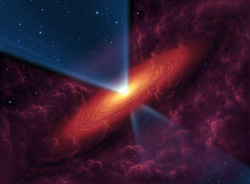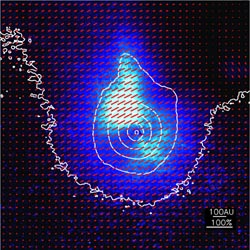

Although the formation process of low mass stars like our Sun has been well understood, the birth of high-mass stars with more than eight solar masses still remains a mystery. A recent study by CAS astronomers and their collaborators from Japan and UK offered direct observational evidence for demystifying the puzzle. The work has been published in September 1 issue of
Nature.
Currently there are two major rival hypotheses for the massive star formation. In one scenario, the process occurs when several low-mass young stellar objects within highly crowded star-forming regions collide and merge. In the other scenario, such star is formed by accretion from a circumstellar disk, which is a flattened system of dust and gas surrounding a protostar at the center, in the same way as its low-mass cousins are formed.
One of the major difference between the two hypotheses is whether there is a coexisting system of a central star, a bipolar outflow, a circumstellar disk and an envelop. And one of the critical evidence for the judgement is the existance of the circumstellar disks. However, it is difficult to spot such disks because high-mass stars are relatively rare and usually distant, and the luminance of disks is always dwarfed by that of protostars.
Using the world large telescope SUBARU and associated instrument CIAO, Dr. Jiang Zhibo and colleagues at the CAS Purple Mountain Observatory in east China's Nanjing city have found a butterfly-shaped structure around the Becklin-Neugebauer (BN) protostellar object in the region of Orion constellation about 1,500 light years away.
With a possible mass ranging from 7 to 13 solar masses, the protostar is only a 100,000-year-old "fetus" compared with billions-of-years-old stars, says Dr Jiang, lead author of the
Nature article. The disk we have observed is just like the "placenta" to the "fetus" star, providing dust and gas as its "nutrient." This gives direct evidence for the accretion model for the formation of massive stars. "Our work suggests that stars up to seven solar masses can be formed through gravitational collapse and subsequent mass accretion," adds Dr Jiang.
Together with another independent study conducted by astronomers at the Harvard Smithsonian Center for Astrophysics in US, "the observations provide a consistent picture of accretion that includes not just disks, but also rotating, infalling envelopes and outflows. These are just the ingredients that would, according to recent theories of accretion, allow the formation of massive stars: material that accretes into the cooler equatorial regions can be shielded from the extreme radiation of the star that normally halts the flow, whereas intense stellar radiation is channelled into the outflow cavities," comments Barbara A. Whitney from the U.S. Space Science Institute.
The finding is also of significance for understanding the formation process of the 4.6-billion-year old solar system, and may shed light on the searching of possible extraterrestrial life, according to experts.






